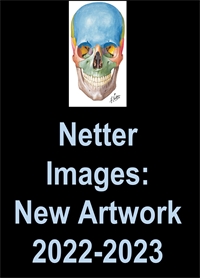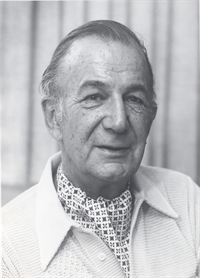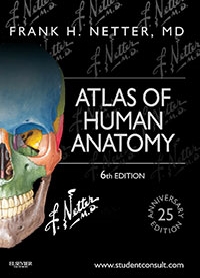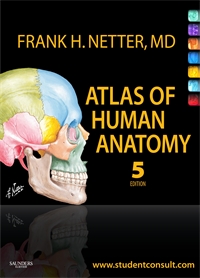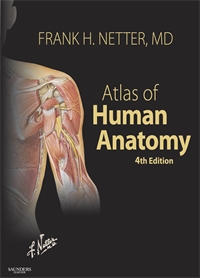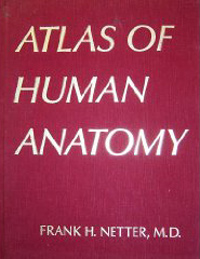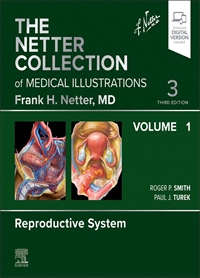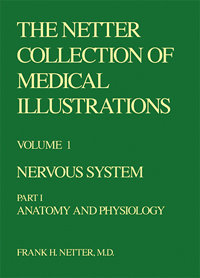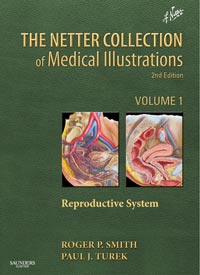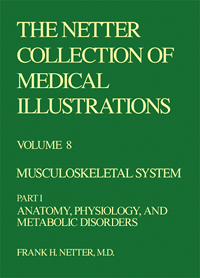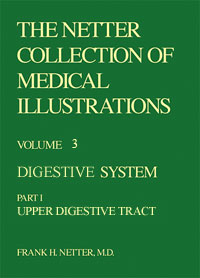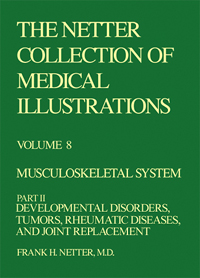Collection of Medical Illustrations, Nervous System - Volume 1, Part 2
Author: Frank H. Netter, MD
ISBN: 9780914168119
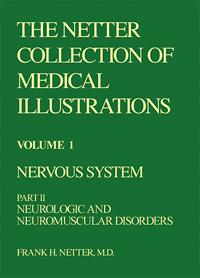
- Page 3: Action of Drugs on Nerve Excitability
- Page 3: Action of Drugs on Nerve Excitability
- Page 4: Action of Drugs on Nerve Excitability
- Page 4: Action of Drugs on Nerve Excitability
- Page 5: Action of Drugs on Nerve Excitability
- Page 6: Brain Malformations
- Page 6: Brain Malformations
- Page 6: Brain Malformations
- Page 7: Brain Malformations
- Page 8: Hydrocephalus
- Page 9: Shunt Procedure for Hydrocephalus
- Page 10: Spinal Dysraphism
- Page 10: Spinal Dysraphism
- Page 11: Spinal Dysraphism
- Page 13: Cerebral Palsy
- Page 14: Floppy Baby
- Page 15: Hypotonia
- Page 16: Werdnig-Hoffmann Disease
- Page 17: Hereditary Motor-Sensory Neuropathy Type III
- Page 18: Nemaline Myopathy
- Page 19: Brachial Plexus and/or Cervical Nerve Root Injuries at Birth
- Page 20: Metachromatic Leukodystrophy
- Page 20: Metachromatic Leukodystrophy
- Page 21: Friedreich's Ataxia
- Page 22: Developmental Dyslexia
- Page 23: Infantile Autism
- Page 25: Brain Tumors in Children
- Page 25: Brain Tumors in Children
- Page 26: Tuberous Sclerosis
- Page 27: Reye's Syndrome
- Page 31: Migraine
- Page 32: Muscle Contraction Headache
- Page 33: Giant-Cell (Temporal) Arteritis, Polymyalgia Rheumatica
- Page 34: Trigeminal Neuralgia
- Page 35: Causes of Vertigo
- Page 36: Alcoholism
- Page 37: Amnesia
- Page 39: Sleep Disorders
- Page 40: Electroencephalography
- Page 41: Causes of Seizures
- Page 42: Generalized Tonic-Clonic Seizures
- Page 43: Absence (Petit Mail) Seizures
- Page 45: Simple Partial Seizures
- Page 46: Status Epilepticus
- Page 48: Differential Diagnosis of Coma
- Page 51: Stroke
- Page 52: Role of Platelets in Arterial Thrombosis
- Page 53: Atherosclerosis, Thrombosis and Embolism
- Page 54: Temporal Profile of Transient Ischemic Attack (TIA), Residual Ischemic Neurologic Deficit (RIND), and Completed Infarction (CI);
- Page 55: Stenosis or Occlusion of Carotid Artery
- Page 56: Ischemia in Internal Carotid Artery Territory: Clinical Manifestations
- Page 57: Potential Collateral Circulation Following Occlusion of Internal Carotid Artery
- Page 58: Occlusion of Middle and Anterior Cerebral Arteries
- Page 59: Lacunar Infarction
- Page 60: Ischemia in Vertebrobasilar Territory: Clinical Manifestations
- Page 61: Ischemia in Vertebrobasilar Territory: Clinical Manifestations Related to Site
- Page 62: Extracranial Occlusive Disease of Vertebral and Subclavian Arteries
- Page 63: Intracranial Occlusion of Vertebral Artery
- Page 64: Occlusion of Basilar Artery and Branches
- Page 65: Occlusion of ""Top of Basilar"" and Posterior Cerebral Arteries
- Page 66: Cardiac Sources of Cerebral Emboli
- Page 67: Uncommon Etiologic Mechanisms in Stroke
- Page 70: Noninvasive Tests for Carotid Artery Blood Flow
- Page 71: Noninvasive Tests for Carotid Artery Blood Flow
- Page 72: Angiography of Cervical and Cerebral Vessels
- Page 74: Clinical Evaluation and Therapeutic Options in Stroke
- Page 75: Endarterectomy for Extracranial of Carotid Artery Atherosclerosis
- Page 76: Intracerebral hemorrhage (Hypertensive): Pathogenesis
- Page 77: Intracerebral Hemorrhage: Clinical Manifestations Related to Site
- Page 80: Distribution of Congenital Cerebral Aneurysms
- Page 81: Giant Congenital Aneurysms
- Page 82: Ophthalmologic Manifestations of Cerebral Aneurysms
- Page 83: Clinical Manifestations of Congenital Aneurysm Rupture
- Page 84: Frontotemporal Approach for Internal Carotid, Ophthalmic, Anterior Communicating, and Middle Cerebral Aneurysms
- Page 85: Temporal Approach for Basilar Trunk or Posteriorly Directed Basilar Apex Aneurysm
- Page 86: Aneurysm Clips
- Page 87: Hypoxic Brain Damage and Brain Death
- Page 90: Compound Depressed Skull Fractures
- Page 91: Basilar Skull Fractures
- Page 92: Epidural Hematoma
- Page 93: Initial Management of Severe Head Injuries
- Page 94: Glasgow Coma Scale
- Page 96: Acute Intracranial Hematoma
- Page 97: Acute Subdural Hematoma
- Page 98: Craniostomy for Chronic Subdural Hematoma
- Page 98: Craniostomy for Chronic Subdural Hematoma
- Page 99: Ventriculostomy
- Page 100: Intensive Medical Management of Severe Head Injury
- Page 101: Respiratory Exchange in Head Injury
- Page 102: Salt and Water Balance in Head Injury
- Page 103: Carotid-Cavernous Fistula
- Page 104: Balloon Embolization of Carotid-Cavernous Fistula
- Page 105: Prognosis in Severe Head Injuries
- Page 106: Cervical Spine Injury: Incomplete Spinal Cord Syndromes
- Page 107: Cervical Spine Injury: Flexion and Flexion-Rotation
- Page 107: Cervical Spine Injury: Flexion and Flexion-Rotation
- Page 108: Cervical Spine Injury: Hyperextension
- Page 109: Cervical Spine Injury: Compression
- Page 109: Cervical Spine Injury: Compression
- Page 111: Cervical Spine Injury: Traction and Bracing
- Page 111: Cervical Spine Injury: Traction and Bracing
- Page 112: Cervical Spine Injury: Anterior Interbody Fusion by Dowel Graft (Cloward)
- Page 113: Cervical Spine Injury: Posterior Fusion
- Page 114: Cervical Spine Injury: Rehabilitation of Patient
- Page 116: Some Common Manifestations of Brain Tumors
- Page 117: Pseudotumor Cerebri
- Page 118: Gliomas
- Page 118: Gliomas
- Page 119: Tumors Metastatic to Brain
- Page 120: Meningiomas
- Page 120: Meningiomas
- Page 121: Meningiomas
- Page 122: Pituitary Tumors
- Page 123: Transsphenoidal Removal of Pituitary Tumor
- Page 124: Craniopharyngiomas
- Page 124: Craniopharyngiomas
- Page 125: Tumors of Pineal Region
- Page 126: Acoustic Neurinomas
- Page 127: Removal of Acoustic Neurinoma: Posterior Fossa Approach
- Page 128: Neurofibromatosis (von Recklinghausen's Disease)
- Page 129: Intraventricular Tumors
- Page 130: Chordomas
- Page 136: Major Depression
- Page 137: Dysthymic Disorder
- Page 138: Bipolar Affective Disorder: Manic Episode
- Page 139: Anxiety State
- Page 140: Schizophrenic Disorder
- Page 141: Compulsive Personality Disorder
- Page 145: Alzheimer's Disease: Clinical Manifestations, Progressive Phases
- Page 146: Alzheimer's Disease: Pathology
- Page 147: Testing for Defects of Higher Cortical Function
- Page 148: Dominant Hemisphere Language Dysfunction
- Page 149: Nondominant Hemisphere Higher Cortical Dysfunction
- Page 150: Treatable Dementias
- Page 151: Normal-Pressure Hydrocephalus
- Page 152: Chorea
- Page 153: Parkinsonism: Early Manifestations
- Page 154: Parkinsonism: Successive Clinical Stages
- Page 155: Parkinsonism: Successive Clinical Stages
- Page 156: Parkinsonism: Hypothesized Role of Dopa
- Page 158: Bacterial Meningitis
- Page 159: Bacterial Meningitis
- Page 160: Parameningeal Infections
- Page 160: Parameningeal Infections
- Page 161: Nocardiosis
- Page 162: Toxoplasmosis
- Page 163: Neurosyphilis
- Page 165: Tetanus
- Page 167: Poliomyelitis
- Page 168: Poliomyelitis
- Page 168: Poliomyelitis
- Page 169: Herpes Zoster
- Page 170: Herpes Simplex Encephalitis
- Page 171: Slow Virus Infections
- Page 182: Motor Impairment Related to Level of Spinal Cord Injury
- Page 183: Sensory Impairment Related to Level of Spinal Cord Injury
- Page 184: Acute Spinal Cord Syndromes: Evolution of Symptoms
- Page 185: Acute Spinal Cord Syndromes: Pathology, Etiology and Diagnosis
- Page 186: Tumors of Spinal Column
- Page 186: Tumors of Spinal Column
- Page 187: Tumors of Spinal Cord
- Page 187: Tumors of Spinal Cord
- Page 187: Tumors of Spinal Cord
- Page 190: Syringomyelia
- Page 190: Syringomyelia
- Page 191: Subacute Combined Degeneration
- Page 192: Cervical Spondylosis
- Page 196: Examination of Patient with Low Back Pain
- Page 197: Clinical Features of Herniated Lumbar Nucleus Pulposus
- Page 197: Lumbar Disc Herniation: Clinical Manifestations
- Page 198: Psychosomatic Back Complaints
- Page 199: Spinal Stenosis
- Page 199: Spinal Stenosis
- Page 200: Diabetic Radiculopathy
- Page 201: Brachial Plexopathy
- Page 188189: Myelographic and CT Characteristics of Spinal Tumors
- Page 204: Diseases of Motor-Sensory Unit: Regional Classification
- Page 205: Laboratory Studies in Neuromuscular Diseases: Electromyography and Serum Enzymes
- Page 206: Muscle Biopsy: Technique
- Page 207: Sections from Muscle Biopsy Specimens
- Page 208: Motor Neuron Disease: Early Clinical Manifestations
- Page 210: Motor Neuron Disease: Habilitation Devices and Procedures
- Page 211: Bell's Palsy
- Page 212: Carpal Tunnel Syndrome
- Page 213: Other Compressive or Entrapment Neuropathies
- Page 214: Peripheral Neuropathies: Metabolic, Toxic and Nutritional
- Page 215: Dysproteinemia (Amyloid Neuropathy)
- Page 216: Peripheral Neuropathy Caused by Heavy Metal Poisoning
- Page 217: Mononeuritis Multiplex with Polyarteritis Nodosa
- Page 220: Hereditary Motor-Sensory Neuropathy Type I
- Page 221: Hereditary Motor-Sensory Neuropathy Type I: Motor Nerve Conduction Velocity
- Page 222: Hereditary Sensory Neuropathy
- Page 223: Leprosy
- Page 224: Myasthenia Gravis: Clinical Manifestations
- Page 225: Myasthenia Gravis: Etiologic and Pathophysiologic Concepts
- Page 227: Lambert-Eaton Syndrome
- Page 228: Duchenne's Muscular Dystrophy
- Page 229: Duchenne's Muscular Dystrophy
- Page 230: Other Types of Muscular Dystrophy
- Page 231: Myotonic Dystrophy
- Page 232: Polymyositis/Dermatomyositis
- Page 233: Polymyositis/Dermatomyositis
- Page 234: Myopathies Related to Disorders of Potassium Metabolism
- Page 235: Myopathies Secondary to Endocrine Disorders
- Page 236: McArdle's Disease
- Page 237: Myoglobinuric Syndromes
- Page 238: Food-Borne Neurotoxins
- Page 218219: Guillain-Barre Syndrome

